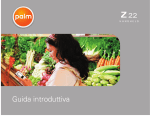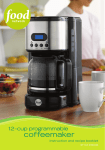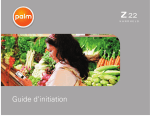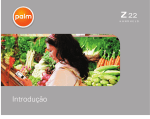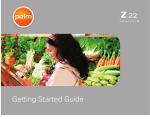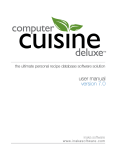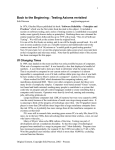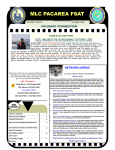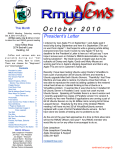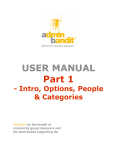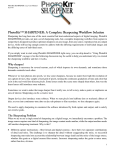Download MacGourmet Deluxe User Guide 03 no appendix D
Transcript
MacGourmet Deluxe User Guide Under the copyright laws, this manual may not be copied, in whole or in part, without the written consent of Advenio or Mariner Software, Inc.. Your rights to the software are governed by the accompanying software license agreement. MacGourmet is a trademark of Advenio, Inc. Mac and the Mac logo are trademarks of Apple Computer, Inc., registered in the U.S. and other countries. Apple, the Apple logo, AppleScript, and Macintosh are trademarks of Apple Computer, Inc., registered in the U.S. and other countries. The "Built for Mac OS X" graphic is a trademark of Apple Computer, Inc. used under license. All other products and company names mentioned in this document may be trademarks of their respective owners. ©2004-2010 Advenio, Inc. All Rights reserved. ©2004-2010 Mariner Software, Inc. All Rights reserved. 1 Getting Started With MacGourmet Deluxe! Installing MacGourmet Plug-ins! 10 MacGourmet Feature Overview! 11 Recipe Box Widescreen and Normal Display Modes! 14 Customizing Your Table Columns! 15 Creating and Editing! 15 The Chef View - Your Kitchen Cooking Helper! 17 Viewing More than One List at a Time! 17 Changing the Look of Recipes and Notes! 18 Viewing Larger Versions of Your Images! 18 2 Creating and Editing Recipes! 21 Creating New Recipes! 21 Editing Your Recipes ! 21 The Info Tab! 21 The Ingredients Tab! 22 The Directions Tab! 24 The Preparation Tab! 25 The Notes Tab! 26 The Picture Tab! 27 The Nutrition Tab! 28 3 Creating and Editing Wine Notes! 29 Creating New Wine Notes ! 29 Editing Your Wine Notes! 29 The Info Tab! 3 8 29 The Tasting Notes Tab! 30 The Winemakerʼs Notes Tab! 31 The Label Tab! 32 The Cellar Info Tab! 33 4 Creating and Editing Cooking Notes! 34 Creating New Cooking Notes! 34 Editing Your Notes! 34 The Info Tab! 34 The Picture Tab! 35 5 Finding Things in MacGourmet ! 36 The Search Field! 36 Finding Recipes, Wine Notes and Cooking Notes! 36 Finding Recipes Using “Cupboard Find”! 37 Creating and Using Smart Lists! 37 Doing a Potluck Find! 38 Finding Recipes, Wine Notes and Cooking Notes! 38 Creating Smart Lists from Find Results! 39 6 Importing and Exporting! 40 Using the MacGourmet Clipping Service! 40 Using the MacGourmet Recipe Web Page Import Service! 43 Using File Import and Export! 44 MacGourmet Export Files! 46 7 Publishing Your Recipes and Notes to the Web! 49 4 Publishing Your Recipes to Your Apple .Mac Account! 49 8 The Lists Editor! 52 9 Making Relationships Between Items! 54 Making Links Using the Relationship Manager! 54 10 Creating and Using Shopping Lists! 55 Creating a Shopping List! 55 Editing Your Shopping Lists! 55 Shopping List Columns! 56 Maintaining the Shopping List Favorites & History List! 56 Exporting a Shopping List to Your PDA or to a Text File! 57 11 Printing Your Recipes and Notes! 58 12 Nutritional Analysis! 59 About MacGourmet Nutritional Information! 59 Nutrition Analyses Based on USDA Database! 59 Use MacGourmet Information with Care! 59 Overview! 59 The Nutrition Database! 60 The Mappings Table! 60 The Nutritional Data per Serving Heads-up-display! 61 The Calculation Details Window! 61 Calculating Nutritional Data for a Recipe! 62 The Weight Resolver: Providing Needed Additional Information! 63 When Mappings Are Not Found! 63 5 Recalculating Your Nutritional Information! 64 Comparing MacGourmet: Nutrition Data to Data With a Recipe! 65 Adding a New Nutritional Item! 67 Deleting Your Nutritional Items! 68 USDA Food Groups! 69 13 Meal Planning! 71 Planning Your Meals with the Weekly Planner! 71 Adding Meals and Recipes to your Planner! 71 Adding Notes to your Weekly Planner! 72 Printing your Weekly Planner! 73 Creating Shopping Lists! 73 Creating and Printing Menus! 74 Sending your Planner to iCal! 76 Using Mealplan with iCal! 76 Setting Mealplan Preferences! 76 Weekly Planner! 76 Printed Planner! 76 Print Vertically! 76 Include Recipes When Printing! 76 14 Creating Cookbooks! 6 77 Building Your Cookbook! 77 Chapters! 78 Text Pages! 78 Image Pages! 79 Blank Pages! 79 Text Blurbs! 79 Creating a PDF Cookbook! 80 Publishing and Printing Your Cookbook! 80 Tips for Creating Your Cookbook! 80 Appendix A! 82 Backing Up Your MacGourmet Library! 82 Changing the Location of Your MacGourmet Library! 83 Appendix B! Configuring the Services menu in Mac OS X 10.6(Snow Leopard)! Appendix C! 84 84 85 Managing MacGourmet Plug-ins With the Plug-in Manager! 85 Built-in Plug-ins! 85 Adding, Removing and Disabling Optional Plug-ins! 85 7 1 Getting Started With MacGourmet Deluxe This chapter introduces you to MacGourmet Deluxe Welcome to MacGourmet! In this chapter, you will be introduced to the basics of MacGourmet a recipe, wine and cooking note organizer. Running MacGourmet for the First Time When you start MacGourmet for the first time you will be asked a few questions to get you started: Widescreen: More suitable for MacBooks and newer wider display screens, displays your data using 3 side-by-side columns. 3-pane: Used to display your data in the same way that your Mail application does. 8 Summary Views: Single column views that allow you to quickly see and change information, all in a compact space. Multiple Columns: Display your information using a column for each value. Large and Small Icons: Set the size of the icons in the source list on the left-hand side of your recipe box. Creating your MacGourmet library The next prompt will ask you where youʼd like to store your library. Press the “Use Documents” button to keep your library in your Documents folder. Press the “Specify Location” button to specify a different folder for your library. Wherever you decide to create your database, all of your information will be stored in a file named MacGourmet3Database. Donʼt forget to back this library file up from time to time. This database file cannot be moved (without changing the location in Advanced preferences) or renamed, and if this happens, MacGourmet will think that it needs to create a new database when you launch it after doing either of these things. If this happens, you can restore your information by just moving your MacGourmet3Database file back to the original location or by changing the name back to what it was originally. 9 Loading the sample recipes and notes If you want to add some sample recipes, press the “Yes, Please” button to add them to your initial library. If youʼd rather start with an empty library, just press the “No Thanks” button. Installing MacGourmet Plug-ins MacGourmet Deluxe plug-ins come packaged in double-clickable files that will launch MacGourmet Deluxe, if itʼs not already running, and install any new functionality contained in them automatically for you. There are many plug-ins available for MacGourmet Deluxe, free extras like, tools and importers for both recipe file formats and web sites. MacGourmet Package File: Just doubleclick to install its contents. To uninstall a plug-in, you only need to double-click on the package file again, and choose the “Uninstall” option when an existing version of the plug-in is detected. 10 MacGourmet Feature Overview Your recipe box has 3 main lists for storing your items, “Recipes,” “Notes” and “Wine Notes.” Each of these lists holds the master copy of each respective item type in your database. You can easily put items in lists that you create, but they really just refer back to the master copy. For instance, if you create three of your own lists and then drag a recipe from your “Recipes” list to each of these three lists, you will see four copies of your recipe in different locations. There will, however, only be one REAL copy. The other three recipes that you see in the lists you created are really just pointers back to the master copy. This means that modifying that recipe anywhere will change all the instances of that recipe, no matter where you put it. If you delete an item in one of your lists, it is removed from your list. It is not removed from your database however, unless you explicitly delete it, or you delete it from one of your master lists. 11 Recipes Your “Recipes” list shows you all of the recipes in your database. This list can only contain recipes. If you delete a recipe from this list, it will get deleted from your database. Notes Your “Notes” list like your “Recipes” list, shows you all of your notes. Deleting and copying notes from this list works like deleting and copying recipes from your “Recipes” list. Shopping Lists This list shows you all of your current shopping lists. Unlike recipes, wine and cooking notes, shopping lists can only exist in this list. When you create a shopping list from one or many recipes, it will get added to this list. Deleting a shopping list from this list will delete it from your database. You can add a new shopping list by dragging one or more recipes to this list, in addition to the normal ways of creating new items. For more information on shopping lists, please see section 10. Wine Notes Your “Wine Notes” like your “Recipes” list, shows you all of your wine notes. Deleting and copying notes from this list works like deleting and copying recipes from your “My Recipes” list. Clippings The Clippings list contains selections of text “clipped” from web sites, using the “Make MacGourmet Text Clipping” menu item in the Services menu, by dragging text from other applications to this list, and by pasting text into this list. Clippings can be doubleclicked and imported using the Recipe Import Assistant. Featured Featured lists are lists of recipes, etc., that are published on the MacGourmet website and displayed within MacGourmet. This list is retrieved from the web, and includes lots of recipe packages put together for MacGourmet users. Importing them is as simple as finding the packages or recipes that you want to try and dragging the package or recipe image to a list in your Recipe Box, or by clicking on the image for a package or recipe. This content will be updated regularly and will offer users a quick and easy way to add great recipes to their collections. 12 Find Results The results of searches you do using the Find menu appear in this list. Last Import Your "Last Import" list displays the items that were added to your database the last time you imported something. Every time you do an import, the current list items are replaced with any newly imported items. Don't worry though, because even though the items were removed from your "Last Import" list, you will still be able to find them in your appropriate "My" list and anywhere you might have copied them. Smart Lists Smart Lists allow you to create lists of items that match find criteria you specify. Once created, they can be configured to keep themselves up-to-date as you make changes to your database, like imports, rating changes, etc. To create a new Recipe Smart List: 1. Click on the view that holds all of your lists. 2. Right-click or Ctrl-click on the list and choose New > Smart Recipe List from the menu. 3. Alternatively, choose File > New > Smart Recipe List. User Lists (Lists and Sub-lists Created By You) User lists, unlike your master lists, can contain sub-lists, and any kind of item. Also, unlike your master lists, deleting an item from a user list doesn't remove it from your database. It only removes it from its user list. Unless you delete an item from a master list, it can be added to and deleted from any user list, and moved and copied to any location that you would like. Removing an item from its master list however, will also remove it from any list that contains it. This means that if you remove a recipe from your “My Recipes” master list, it will also be removed from all of your user lists that contain it. To create a new User List: 1. Click on the left-hand view that holds all of your lists, so that it has the focus. 2. Press the “+” button at the bottom left of your recipe box. 13 To create a sub-list in a list: 1. Select the list you want to add the new sub-list to. 2. Right-click or Ctrl-click on the list and choose New > List from the menu. 3. Alternatively, choose File > New > List or ⇧⌘G (shift-⌘-G). Recipe Box Widescreen and Normal Display Modes Your recipe box is able to display your information in two different modes, widescreen and normal. Widescreen mode stacks your columns side-by-side and can better take advantage of more recent Apple widescreen displays. You can see this in the image that begins this chapter. The normal, or “Mail” mode uses a display similar to that used by Appleʼs Mail application. The mode used can be set in Preferences. In addition to these modes, the column that displays the items in the main selected list can also be shown using either the normal multi-column “list”, or using a “summary” version of the list, which are more suited to widescreen mode. When displayed using summaries, the items in the list will be displayed in a single column, with taller rows that contain a summary of information for the selected item, including its image, etc. You can quickly flag, rate, scale and mark recipes as prepared by clicking on the respective icons in the summary views. To toggle between list and summary lists, select the item list and choose View > Use Columns or View > Use Summaries (depending on that the current selection is). Finally, you can also display the icons in the source list on the left in two ways: with large icons, or using smaller icons. To change this setting, select something in the source list and choose View > Use Small Icons or View > Use Big Icons. 14 Customizing Your Table Columns The table columns of each type of recipe box list is customizable. This lets you show only the columns you are interested in. It also allows you to display them in the order you desire. To access the list of columns to display: Hold the right mouse button down (or press the ctrl key on your keyboard and hold down the mouse button) and click on any table column. When you do this, a menu with all of the available columns is displayed, with a check mark next to all of the columns that are set to display. If you want to hide a column, just select a checked column name from the list, the checkbox next to the item will no longer appear, and the column will be hidden in your recipe box. To show column, select an unchecked column from the list to add a checkbox, and the column will be then displayed. You can also choose View > View Options... when the list is selected to display the Options window: Note: this can only be used when using columns, not when using summaries. To rearrange your columns: Click on a column header and drag it to a new position. Note that there are different columns for different list types. For instance, selecting a list that only displays recipes will have recipe-related columns available, selecting a wine note will have wine-note related, etc. User lists, because they can contain any type of item, will only display columns that are common to all of the items it can contain. Creating and Editing You can edit and view recipes and notes simply by double-clicking on an item in a list to open its editor. Double-clicking on a recipe, for example, will open the recipe editor. The editor for an item allows you to view and change any of the itemʼs information, including 15 adding notes and pictures. Creating an item is done by selecting the appropriate menu item from the File > New submenu. You can also use the “New” toolbar item, which will create a new item for the selected list. If you are in one of your user lists, which can contain different kinds of items, you will be prompted for the type of item to create. You can display editors as both dialog windows and sheets, which are attached to the main window. To specify the editing style youʼd like to use, change the “Display editors as sheets” option in Preferences. 16 The Chef View - Your Kitchen Cooking Helper If you have your laptop or computer in the kitchen with you while you cook, you can display any recipes you are working on in a Chef View. Chef Views are windows containing a view of your recipe that is optimized for use while cooking. The text is large enough so that you can read the ingredients and directions from a distance. This view also displays only what you need to see while cooking, the list of ingredients and the directions. This means no extra fluff like the pictures, ads and web navigation that you get when displaying a recipe on a web site in a web browser. MacGourmetʼs chef view will speak the text of the selected recipe or ingredient if enabled, and it will also respond to voice or Apple remote commands. Viewing More than One List at a Time Not content with just viewing and organizing your recipes and notes in your recipe box? No problem. MacGourmet allows you to open lists in their own windows, with their own item views, for extra flexibility. This allows you to see one of your lists in its own “recipe box” like window, without a view on the left side. In addition, updating or adding anything to a list when viewed in its own window will also cause the update to happen in your main recipe box, keeping everything synchronized for you. 17 To view a list in its own window, select a list and either press the “View List” toolbar item, or choose “View List” from the File menu. Changing the Look of Recipes and Notes MacGourmet doesn't give you just one set of fonts and colors for displaying recipes and notes. Go to the General Preferences tab and select the look you want with a recipe selected in your recipe box to see the layout change Viewing Larger Versions of Your Images While the image for a selected item may be small, to make it easier to display more information, you can see a larger size of any image, if there is one, by clicking on the image in your recipe box. Viewing More than One Item at a Time Displaying read-only versions of more than one item at a time can be done by choosing File > Display Item for each item. 18 Scaling Your Recipes MacGourmet allows you to arbitrarily change the number of servings, by scaling the original servings amount. To scale the servings of a recipe, you first need to have entered a servings amount. Then, you can scale your recipe in one of two ways: If you are using the Summary views, you can just click on the icon to display the scaling window. To change the number of servings, you just enter a new amount and press “Scale”. You can reset your recipe to the original servings amount by pressing the “Reset” button. Another way to scale your a selected recipe is to select it and choose: Edit > Recipe > Scale Servings This is display the scaling window, seen below. Changing the servings works the same way as using the pop up scaler, described previously, does. Scaling your recipes doesnʼt actually change the original, it just creates a scaled “view” of the original recipe. You can always go back to the original servings amount by displaying one of the scaling windows and pressing the “Reset” button. 19 Recipe Box Toolbar Icons New - Add a new item Delete - Delete the selected item or items Get Info - Display the editor for the item New Shopping List - Create a new shopping list using the selected recipes Chef View - Display the chefʼs view for the selected items Print - Print the selected items Export - Export the selected items Import - Import items into your library Lists Editor - Edit categories, courses. equipment, cuisines, etc. Send Email - Email the selected items View List - Display the selected list in a separate window Nutrition Database - Display the database main window Weekly Planner - Display the Mealplan weekly planner window Cookbook Builder - Display the Cookbook builder window) 20 2 Creating and Editing Recipes This section describes creating and editing your recipes. Creating New Recipes To create a new recipe, choose File > New > Recipe (⌘-N). This creates a new empty recipe in the currently selected list, provided it is editable and can contain recipes. Editing Your Recipes You can edit and view recipes simply by double-clicking on one in one of your lists or by selecting something in your recipe box and choosing File > Get Info. The Info Tab Keywords - for entering freeform text to associate with the recipe. Yield - for entering the product of the recipe, such as 24 cookies. Different from servings, which are used for nutritional calculation and which can only be a number. Servings stores the actual number of servings the recipe makes. 21 Categories table - allows you to set categories for the recipe used for searching and organizing your recipes. Fields marked with a are user created categories. Fields marked with a are system categories and categories marked with a are locked and canʼt be deleted. The Ingredients Tab Quantity The quantity needed for an ingredient. Measurement - The measurement of the ingredient. Description What the ingredient actually is. Directions Instructions associated with the ingredient, like “chopped” or “diced” Is Main Whether or not an ingredient is a main recipe ingredient. Marking an ingredient a “main” ingredient makes it easier to search. Measurement System - The measurement system used by the ingredients: U.S. Standard or metric. Commands New - Add a new ingredient row 22 Delete - Delete the selected ingredient row or rows Add Group - Add a new ingredient group to the list. Drag and drop ingredient rows into a group to organize your list. Add Recipe as Ingredient - Add a recipe as an ingredient to the list. 23 The Directions Tab Entering Steps and Step Details Each step for a direction can have the text of a step, a label, and image and a way to highlight it in the directions list. To edit the values, you just need to select a direction and edit the values in the “Step Detail” section of the editor. Your changes are entered immediately and saved when you move to another step or recipe or when you close the editor. 24 The Preparation Tab Preparation Times 1. Type - The type of time, like “Start to Finish” or “Prep” 2. Amount - The amount and units, for instance 25 Minutes, or 1 Hour 30 Minutes. Equipment Any special equipment that is required by the recipe. Check any that are needed. Fields marked with a are equipment youʼve added. Fields marked with a are equipment included by default. 25 The Notes Tab Introduction/ Summary Enter a summary here. This can be an introduction to the recipe, why itʼs great, a little story associated with it, etc. Recipe Notes Any notes helpful when making the recipe. To edit the values, you just need to select a note and edit the values in the “Note Details” section of the editor. Your changes are entered immediately and saved when you move to another note or recipe or when you close the editor. Available Note Tags Chef Cooking Pairing Prep Serving Private - Personal notes that arenʼt exported 26 The Picture Tab 1. Image Well The area that displays the primary image for the recipe. You can drag and drop an image to this area to change the picture, or select it and choose Edit > Paste. 2. The Crop Box - Dragging this box around and pressing the “Crop” button allows you to save only part of the image as the primary image for the recipe. 3. Clear - Clears the current picture, making it so that the recipe no longer has a picture. 4. Crop - Uses the area surrounded by the “Crop box” to specify a smaller, more focused version of an image as the primary image. 5. Reset - Resets a cropped image to the original version. 6. Open - Allows an image for the recipe to be opened from your computerʼs disk drive. 7. Size slider - Changes the size of the crop box. 27 The Nutrition Tab The nutrition Notes tab allows you to record alreadycalculated nutritional information for the recipe. The Calculated tab enables you to calculate nutritional data for your recipes. For more information, please see section 12, Nutritional Analysis. 28 3 Creating and Editing Wine Notes This section describes creating and editing your wine notes. Creating New Wine Notes To create a new wine note, choose File > New > Wine Note (⇧-⌘-W). This will create a new empty wine note in the currently selected list, provided it is editable and can contain wine notes. Editing Your Wine Notes You can edit and view notes simply by double-clicking on one in a list or by selecting something in your recipe box and choosing File > Get Info. The Info Tab Style - The wine style, like light, medium, full-bodied, etc. Type - The wine type, such as Red: Cabernet Sauvignon. Keywords Enter any keywords or text that youʼd like associated with a wine note. 29 The Tasting Notes Tab Rating - A rating of how much you enjoyed the wine. Tasting Notes Any notes or thoughts that you had about the wine after tasting it. 30 The Winemakerʼs Notes Tab Winemaker Notes - Notes from the winemaker about their product. Winemaker URL - The web address of the winemaker. 31 The Label Tab Image Well Displays the primary image for the recipe. You can drag and drop an image to this area to change the picture, or select it and choose Edit > Paste. Crop Box Dragging this box around and pressing the “Crop” button allows you to save only part of the image as the primary image for the recipe. Clear - Clears the current picture, making it so that the recipe no longer has a picture. Crop - Uses the area surrounded by the “Crop box” to specify a smaller, more focused version of an image as the primary image. Reset - Resets a cropped image to the original version. Open - Allows an image for the recipe to be opened from your computerʼs disk drive. Size slider - Changes the size of the crop box. 32 The Cellar Info Tab Purchase Location Displays the place you bought the wine. Purchase Date - displays the date you purchased the wine. Maturation Date - displays the date the wine should be “ready”. Date Opened - records the date you opened the bottle. Number On Hand - displays the number of bottles in your collection. Price - records the price you paid for the bottle. 33 4 Creating and Editing Cooking Notes Creating and editing your cooking notes. Creating New Cooking Notes To create a new cooking note, choose File > New > Cooking Note (⇧-⌘-N). This will create a new empty cooking note in the currently selected list, provided it is editable and can contain cooking notes. Editing Your Notes You can edit and view notes simply by double-clicking on one in a list or by selecting something in your recipe box and choosing File > Get Info. The Info Tab Title - displays the name of the note. Source - records where you found the recipe. Keywords an area for free-form text entry which will associate with the recipe and facilitate easier searches. Note Text records any info or cooking tips, or tricks. 34 The Picture Tab Image Well Displays the primary image for the recipe. You can drag and drop an image to this area to change the picture, or select it and choose Edit > Paste. Crop Box Dragging this box around and pressing the “Crop” button allows you to save only part of the image as the primary image for the recipe. Clear - Clears the current picture, making it so that the recipe no longer has a picture. Crop - Uses the area surrounded by the “Crop box” to specify a smaller, more focused version of an image as the primary image. Reset - Resets a cropped image to the original version. Open - Allows an image for the recipe to be opened from your computerʼs disk drive. Size slider - Changes the size of the crop box. 35 5 Finding Things in MacGourmet Finding recipes and notes in your MacGourmet database. There are a variety of ways to find things in MacGourmet. You can quickly filter on certain fields, or all fields in your recipe box using the Search Field. You can search for recipes, wine notes and cooking notes using the basic search functionality. You can create Smart Lists that search for items based on criteria you specify: lists that keep themselves updated as you add and delete items. You can search for recipes based on ingredients you have and ingredients you do not have. Finally, you can do "Potluck" searches that return random selections from your recipe collection. This is great if you can't decide what to make! The Search Field The search field is found on the toolbar of your recipe box and your list views. It allows you to pick a field to search on and quickly filter the selected list based on whatever you type into this field. Finding Recipes, Wine Notes and Cooking Notes Basic search allows you to search for recipes, wine notes and cooking notes using the fields that correspond to each of those items. For instance, you can search for recipes using name, keywords, source, etc. You can search for wine notes using vintage, the region or comments in a winemaker's note. When you search, your results are displayed in the “Find Results” list in your recipe box. Your find results will be saved for your current MacGourmet session, but quitting the application and restarting it later will clear the “Find Results” list, so that it does not get too cluttered with old searches. 36 L Tip: You can move the cursor to the search field by pressing ⌥⌘F (option-⌘-F). Finding Recipes Using “Cupboard Find” Cupboard Find is an easy and quick way to find recipes based on ingredients you have and ingredients you do not have. For instance, the screenshot below shows a recipe search that calls for chicken and potatoes, but not garlic, because you donʼt have any garlic. When your search is complete, your results are displayed in the Find Results list of your recipe box. To display the Cupboard Find window: Choose Edit > Find > Cupboard Find... (You can also press ⌘-F). Creating and Using Smart Lists Let MacGourmet create recipe and note lists for you automatically with Smart Lists. Simply specify your criteria — like recipes you have prepared or recipes with a rating greater than 3 — and MacGourmet will do the rest. MacGourmet finds the items that match the things you specify and creates a list that updates itself automatically. If you were to create a Smart List for recipes, using the values shown below, a new list would be created for you that displayed recipes that you have prepared with a rating that is greater than 3. As you marked more recipes as prepared, and rated others, this list would be updated to reflect these changes, provided you had the "Live updating" box checked. Checking the “Limit to” check box would allow the Smart list to show only 20 of the recipes in the database that matched your list settings instead of all of them. 37 L Note: Because Smart Lists are updated each time something in the database changes, adding more and more lists can slow response times in large databases. Large databases will respond most quickly when there are fewer lists that need updating. To create a new smart recipe list: 1. Click on the view that holds all of your lists. 2. Choose File > New > Smart Recipe List. You can also right-click (or ctrl-click for one button mouse users) on the view that holds all of your lists and choose New > Smart Recipe List in the menu that pops up. 3. A new list will be added, which you can rename by double clicking on it. To edit a list, select it and choose Edit > Modify Smart List. You can also select it and right-click (or ctrl-click for one button mouse users) on it to display a menu, from which you can then choose “Modify Smart List.” Doing a Potluck Find Can't decide on what to make? Not a problem. Potluck Find is a fun way to search for 5 random recipes from your collection. To do a new Potluck Find: Choose Edit > Find > Potluck Find. Potluck Find can be used as often as you want, returning a new, different list of recipes each time you use it. Finding Recipes, Wine Notes and Cooking Notes Search for each item type by selecting the appropriate command from the Find menu. 38 To find recipes: Choose Edit > Find > Find Recipes..., or press ⌃⌘R (ctrl-⌘-R). To find wine notes: Choose Edit > Find > Find Wine Notes..., or press ⌃⌘W (ctrl-⌘-W). To find cooking notes: Choose Edit > Find > Find Cooking Notes..., or press ⌃⌘R (ctrl-⌘-N). When you use any of these commands, a Find window appropriate for the type of item you are searching for will be displayed, so that only the information appropriate to the type of item will be available for your search. You can also search your library for potential duplicate recipes. Find Duplicates looks at the directions of each of your recipes and compares them to those of all of your other recipes to see if there are any that might be the same. The ones that look like duplicates are returned in a Find result, and added to the Find Results list in your recipe box. To find duplicate recipes: Choose Edit > Find > Find Duplicates Creating Smart Lists from Find Results You can easily turn your find results into smart lists: 1. Select the Find result in the list 2. Choose File > New > Smart List From Find, to turn it into a Smart List. This will create a new Smart List that uses the criteria in the selected Find result. 39 6 Importing and Exporting Importing and exporting your information. MacGourmet provides a variety of ways to get information into and out of your recipe box. L Note: If you do not see the “Make MacGourmet Text Clipping” menu item in the Services menu, try copying MacGourmet to the system Applications folder. Also, try logging out, and rebooting if that still doesnʼt work. In rare cases you might have to reboot twice. If youʼre using Mac OS X 10.6 (Snow Leopard) please see Appendix B for information on configuring Services. Using the MacGourmet Clipping Service Getting recipes into MacGourmet is as easy as 1-2-3: 1. Go to your favorite recipe web site in your web browser and select the text of a recipe. Hint: Itʼs often easier to clip from a “Print” version of a recipe, which will usually display a recipe without ads and web site navigation. 40 2. With the text of the recipe selected, and your browser the front-most application, select "Clip Recipe" from the Safari Services menu, or press ⇧⌘M (shift-⌘-M). Doing this adds a text clipping of the recipe to the Clippings list in your Recipe Box. L Note: Not all web browsers support the Services menu. Apple's Safari, Camino, and Opera, and the latest versions of Firefox all support the Services menu, but older versions of Firefox, iCab, Microsoft's Internet Explorer, and Googleʼs Chrome currently do not. 41 3. Double click your new clipping to bring up the Recipe Import Assistant. Copy or drag the text from the left text area into the appropriate fields and text areas on the right. Make any corrections or modifications you desire. Text can also be copied to import fields by selecting text in the area one the left hand side of the assistant and choosing the desired target from the popup menu below the top text area, and pressing the Set button. Alternatively, each menu item has an associated keyboard shortcut. 42 Before committing your new recipe, you can see what it will look like when it's imported in the import preview. Other ways to make clippings In addition to using the Services menu item to create and add clippings to your recipe box, you can also create clippings by either dragging and dropping text from another application to the Clippings list, or by copying text from another application, selecting the clippings list in MacGourmet and choosing Edit > Paste. Once youʼve made a clipping, you can import it using the Assistant, the same as you would a web clipping, which is described above. Using the MacGourmet Recipe Web Page Import Service MacGourmet makes it super easy to import recipes from certain, supported web sites including allrecipes.com, epicurious.com, foodnetwork.com, williams-sonoma.com and food.yahoo.com. 1. Go to the recipe page on your favorite, supported web site. Note that you have to go to one of their standard recipe pages for the importers to work. Recipes on featured pages, special pages, etc. are not usually supported by the importer. 2. Select the entire URL in the address bar of your web browser. 3. Choose Safari > Services > Import Recipe From Web Page, or press ⇧⌘O 4. After a moment, a Recipe Import Assistant window (described above) appears with all of the recipe information already filled in. Verify the information is correct, make any desired changes, and press the Save button. Note: Occasionally, because of the many variations of information, the information is not retrieved in its entirety. When this happens, you can still make a web clipping and import the recipe that way. 43 Note: MacGourmet site plugins use web page “scraping” to get recipe information. Recipe web sites tend to change their code often, and this sometimes breaks the web page import service for that site. If this happens, first, check to make sure that you are using the latest version of MacGourmet Deluxe. If you are, sending the URL to support helps us track any changes to the site. While waiting for a fix, you can still import a recipe using the recipe clipping service. L MacGourmet imports files saved in the following formats: MasterCook Text, MasterCook MXP, MasterCook MX2, MasterCook Mac, Meal-Master, Cookʼn text, RecipeML, and Yum XML Using File Import and Export You can choose to import existing files in various formats, described below: 44 Importing Recipes: The image below shows a MasterCook import file selected. While you should make sure that you select the correct file format for your import, MacGourmet will verify that the file you selected matches the selected format before your import starts. To import Yum XML files: 1. Choose File > Export All Recipes > As XML Text... 2. Save the file to your hard drive. 3. Using MacGourmet, choose File > Import... 4. Choose the XML file you created, and select Yum XML for the format of the file to import. To import Cookʼn text files: 1. Export from Cookʼn using their text-based format. 2. Using MacGourmet, choose File > Import... 3. Choose the text file you created, and select Cookʼn for the format of the file to import. To import Recipe ML, MasterCook MXP, MasterCook MX2, and Meal-Master files: 1. To export from a PC based application: select the recipes and export them using one of the text-based formats that matches one of the available importers. 2. Using MacGourmet, choose File > Import... 45 3. Choose the file you want to import and choose the appropriate file format, RecipeML, MasterCook MXP, MasterCook MX2 or Meal-Master. L Hint: To import recipe collections from MasterCook 4.06 for Macintosh you need to take the collections files and convert them to MasterCook export files To import MasterCook Mac files: 1. You need to open a collection, say "15-minute Meals" 2. Go to the index, and select all of the recipes, or just the recipes that you want to export. 3. Select the "Export Selected Recipe(s)" menu item from the Recipe menu, and choose the "Mac Format" menu item in the save dialog. This will create a file that is in the correct format for import into MacGourmet, a MasterCook Mac file. After saving the file as a "Mac Format" file, you can then import that file into MacGourmet. You can also drag and drop an import file into your Recipe Box! Just select an import file in the Finder and drag it into one of your lists, or onto one of your lists. That's all there is to it. Once imported, your new items can be found in both your appropriate "My" list, and in your "Last Import" list. Importing from other Mac Applications In addition to importing from some of the older PC-based apps, MacGourmet can also import from many Mac recipe applications. Doing this just requires the installation of an optional plug-in, which you can do using the Plug-in Manager. For details please see Appendix C. Instructions for using each plug-in will be displayed when the importer is selected in the manager, once itʼs been installed. Exporting Recipes and Notes Exporting items is as easy as importing them. You can export recipes in a variety of formats, described below: MacGourmet Export Files The MacGourmet file export types include three different ways to export both text and binary versions of recipes, wine notes and notes. 46 When you choose to export MacGourmet files, any embedded images will be saved in a format that is smaller and faster to import later. The MacGourmet Text format is useful when putting your export files on a web site or sending them through email. In the text version of the format, any embedded images are converted to text, making them easier to share across different mail and web servers, but also making them larger. Both formats are compatible with MacGourmet 2 and MacGourmet 3. If you want to create smaller export files optimized for MacGourmet 3, just choose the MacGourmet 3 file export format. iPod Notes (for older non-iOS iPods) 1. Choose the list or set of recipes in your recipe box that youʼd like to export to your iPod. 2. Choose File > Export... and choose iPod Note as the format. 3. Choose the location to save your recipes. A folder containing your recipes will be created in this location. Note: if you want to group your recipes in sublists on your iPod, create and choose to export a list in your recipe box that has sublists. 4. Connect your iPod to your Mac, making sure that “Enable disk use” in Settings is checked when you inspect your iPod in iTunes. 5. Drag the folder that was created when you exported to the Notes folder on your iPod, then disconnect it. 6. You should now be able to browse your recipes as iPod notes. 47 Text and Rich Text 1. Choose the list or set of recipes in your recipe box that youʼd like to export. 2. Choose File > Export... and choose either Text File or RTF File as the format. MasterCook, MasterCook Mac and Meal-Master 1. Choose the list or set of recipes in your recipe box that youʼd like to export. 2. Choose File > Export... and choose MasterCook MXP, MasterCook MX2, MasterCook Mac or Meal-Master as the format. Note that you can only export recipes when a format other than one of the MacGourmet formats is selected. Wine and general notes will be ignored. Creating text versions of your recipes and notes Additionally, you can select one or more items and choose Edit > Copy. Doing this will place text versions of the selected items into the Mac OS X Pasteboard, letting you then paste the text into other applications like Mail, TextEdit, Entourage, etc. Exporting the names of items in a list To export the names of all of the items in one of your recipe box lists, select the list, and choose Edit > Copy. This will add a text-based list of all of the item names in the list to your pasteboard, which you can then paste into any application youʼd like. 48 7 Publishing Your Recipes and Notes to the Web Publishing to the web. MacGourmet allows you to publish your recipes, wine notes and general notes to the web, or to your local file system. This allows you to easily share what you've created, entered, etc. with others. Create and modify web site publications by going to the Publish panel in Preferences, and selecting the Sites tab. Publishing Your Recipes to Your Apple .Mac Account MacGourmet allows you to easily publish recipes, wine notes and notes to your Apple .Mac account. To create a new publication: Click the Add button. A sheet appears. 49 Title - This field lets you specify the name of the publication. This name is used both for the publication's entry in the Publish menu, and as the title displayed on the index page of your publication. Summary - This field allows you to specify a brief summary for your recipe and notes sites. Server Type This pop up menu lets you pick which type of server to write your data to. Currently Appleʼs MobileMe, WebDAV, and Local disk are offered. Server - This text field specifies the address of the server to connect to. For MobileMe this value is fixed. Website URL - This field is used to specify the base URL for your recipe site. This URL is the specification of how the user will get to your web site. You can change this to anything you want, but it will also get updated automatically for you as well, using information inserted into other fields. For MobileMe you will usually want to use the default value. Publish Folder - This text field specifies the location on the server or file system where your files should be written. Note that when using MobileMe, that the location Apple specifies is "Web/Sites/YourSiteName" so while you can specify anything you want, the suggested location starts with "Sites" followed by the name of a folder that will contain your site. 50 Create export files for published items - Checkbox that allows you to create MacGourmet export files as part of your publication, so that importing your recipes by other users can be as simple as just dragging the image of an export file from a web page into MacGourmet. Finally, the Template and Style pop up menus allow you to pick one of the included MacGourmet themes for your publication. After creating the specification for your publication, publish it by choosing File > Publish. The Publish menu contains your publications, listed by their titles. Selecting a publication from the menu will create all of the files necessary for your site, in the location you specified. Once the publication is complete, access it using the URL displayed in the field labeled "This site's address is:" when your publication is selected in the Publish preferences table. 51 8 The Lists Editor Modifying and searching categories, equipment, ingredients, and more. The Lists Editor allows you to view and edit most of the information in your database. The lists editor has 4 sections, recipes, wine notes, cooking notes, and shopping lists. Each section has a popup menu that displays fields that can be browsed and edited. When a field in the popup is selected, the middle area of the browser changes to display all of the information associated with the selected field. Fields marked with a are user created and can be changed, or deleted. Fields marked with a are system created values that can be changed or deleted. Fields marked with a and canʼt be changed. are locked To change a value, double-click on it in the table, change the value and press Return to finish. You are also able to see what items use each value in the middle table by selecting something. This updates the “Used By” table at the bottom of the library browser with any items that use the selected value. To go to the item in your recipe box, double-click on the item in the “Used By” table. Note: some lists, like categories, you can directly modify, and some, like Ingredient Descriptions, are built from the information you entered into your database. Because of this, items in a list like “Ingredient Descriptions” can only be “deleted” by removing the 52 values from any items that are using them. If you change one of these values in the middle table, all of the items that use the value will be updated with the new value. When nothing uses a value, it is removed from the list. L NOTE: The Library Browser is a VERY powerful tool and caution should be exercised when using it to modify your information. Make sure you check your changes before pressing “Yes” when you are asked to confirm your change. 53 9 Making Relationships Between Items Linking your recipes and notes. Making Links Using the Relationship Manager MacGourmet features a tool called the "Relationship Manager" that allows you to make links between recipes and notes. This allows you to remember recipes that went well together, wines that went well with recipes, and notes that are useful when preparing certain recipes. To make relationships: 1. Select an item in your Recipe Box and bring up the Relationship Manager, from the Tools menu. Notice that the item shown at the top of the Relationship Manager is the name of the currently selected item. To keep the selection from changing as you select items in your recipe box, press the “Lock” checkbox. 2. Next, find an item in one of your recipe box lists that you want to link to the currently selected item. 3. Once you find it, drag it to the Relationship Manager table. Note that selecting a new item changes the selected item in the Relationship Manager unless youʼve checked the lock checkbox. Note: it is possible to drag an item without selecting it by quickly clicking and dragging the item, in one motion. 4. Drop the item. A new relationship between the selected manager item and the dropped item is created. This relationship is in both directions, which means, if you make a relationship between a “Roasted Lemon Chicken” recipe and a “How to roast a chicken” cooking note, that relationship appears when viewing either item in your recipe box. You can always add more relationships. Delete any relationships by selecting the relationship in the "Related Items" table of the Relationship Manager when a recipe or note is selected, and pressing the Delete key. Double-clicking an item in the relationship manager selects that item in your recipe box. 54 10 Creating and Using Shopping Lists Creating, using and exporting shopping lists. Creating a Shopping List MacGourmet allows you easily to create shopping lists. To create a new shopping list: 1. Select one or more recipes. 2. Next select “Shopping List From Selection” from the File > New menu. You can also select “Shopping List From Selection” from the “New” contextual menu by right clicking or command clicking on a selected recipe. Additionally, create a new, blank shopping list by selecting the “Shopping List...” item from the File > New menu when you have your “My Shopping Lists” list selected in your recipe box. Alternatively, create a new shopping list by selecting one or more recipes and dragging and dropping the selection on the “My Shopping Lists” list on the left side of your recipe box. Combining Shopping Lists Two shopping lists can be merged by dragging one shopping list and dropping it onto another one. When shopping lists are merged, the ingredients in the list are combined. Editing Your Shopping Lists Like recipes and wine notes, you can edit and view shopping lists simply by doubleclicking on one in a list. Double-clicking on a shopping list will open the shopping list editor which allows you to specify the name, and the items for a shopping list. The editor allows you to also specify fields like aisle and store for each item on your list. The editor also allows you do add non-recipe items to your list. To edit values in the editor table, just double-click on the column of the row youʼd like to change. To add or remove a row, just press the appropriate button located above the table. The button marked with a “+” will add a new row, the button marked with the “-” 55 will delete the current selected rows. Shopping List Columns To hide and show columns, just rightclick (or controlclick) on the table column headers and check or uncheck the columns. You can also select the shopping list item table and choose View > View Options... to change the columns that are shown or hidden. Most of the shopping list columns are selfexplanatory, how, the column marked with a $ character will display a coupon icon when displayed for any row that is checked. This is useful when shopping for marking items on your list that you have coupons for. Maintaining the Shopping List Favorites & History List Every shopping list displays a master Favorites list, shown above in the bottom section of the shopping list editor window. The favorites list is a place to keep often used items, such as pantry staples, so that they can be quickly added to any shopping list. To add one or more favorite items to a shopping list, just drag and drop the rows from the favorites list to the shopping list. The favorites list can also be used to store pantry quantities, if desired as well. Items in the favorites list are also used to set the aisles, stores and categories for items whenever a new shopping list is created. For instance, if the favorites list has a row for “all-purpose flour” and a shopping list gets created that uses this ingredient, the values for the “all-purpose flour” favorite item are used to fill in the data for this item in the new shopping list. Alternatively, if there are no favorites found, existing shopping lists are searched for this information and the items in a new shopping list are filled in using the values from existing shopping lists, so itʼs also possible to keep a “master” shopping list that is used to fill in information automatically. 56 Add Delete Exclude - Exclude the selected item from current and future shopping lists. Useful for removing staples like salt, pepper, etc. from your lists. Find - Search a predefined list of items for things to add to your lists. Add to Favorites - Add the selected item to your list of favorites. Exporting a Shopping List to Your PDA or to a Text File MacGourmet lets you easily export your shopping lists to PDAs and to text files. To export a shopping list, select it in your recipe box. Next choose Export... from the File menu. Finally choose a name, location and format for your exported shopping list. MacGourmet currently supports HandyShopper and SplashShopper, and plain text export formats. 57 11 Printing Your Recipes and Notes This chapter describes how to print from MacGourmet. MacGourmet offers you many printing options. You can print one item, or many items. You can print one item per page, or many to a page. To print, select one or many items in your recipe box and press the Print toolbar item, or select Print... from the File menu. The Print window displays The Print window allows you to choose the printing template and gives you an approximate preview of your recipes or items when printed. Note: this view is only approximate. To really see what your print out looks like, press the “Print” button at the bottom of the Print window, which displays the Print Settings sheet, and press the “Preview” button at the bottom-left of the sheet. L Note: You can only print one type of item at a time. This means that if you are in your recipe list, you can select as many recipes as you want and print them. However, if you are in a user list, you can only select multiple items of the same type. To print each of your selected recipes on a separate page, check the “Print one item per page” check box. To change the print margins, press the “Set Margins” button. A sheet appears that allows you to set the top, bottom, left and right margins. Increase the size of the text by moving the “Font Size” slider to the right; moving it to the left reduces the font size. 58 12 Nutritional Analysis Analyzing Nutrition About MacGourmet Nutritional Information Nutrition Analyses Based on USDA Database MacGourmet is proud to use the abbreviated USDA National Nutrient Database for recipe nutrition analysis. Today, the National Nutrient Data Bank is a repository of information for more than 130 nutrients and for over 7,000 foods. It is made available in their principle database--the USDA National Nutrient Database for Standard Reference (SR). U.S. Department of Agriculture, Agricultural Research Service. 2006. USDA Nutrient Database for Standard Reference, Release 19. Nutrient Data Laboratory Home Page, http://www.ars.usda.gov/nutrientdata Note: Release numbers change as new versions are released. Use MacGourmet Information with Care The nutrition values that are calculated by MacGourmet are based on individual recipe ingredients. If a nutrient value is not available at this time, you will not find a mapping for the nutrient name. While Advenio takes the utmost care in providing you with the most accurate nutritional values possible, please note that this information is an estimate and is not intended for medical nutrition therapy. If you are following a strict diet for medical or dietary reasons, it is important that you, first, consult your physician or registered dietitian before planning your meals based on MacGourmet nutritional analysis, and, second, remain under appropriate medical supervision while using the nutrition information calculated by MacGourmet. Overview The MacGourmet:Nutrition plug-in consists of a main window, which provides access of the nutrition database and nutrient items, and a floating heads up display (HUD) window that displays a summary of the calculated nutritional information for a recipe. 59 The Nutrition Database Once the plug-in is installed, the main nutritional database window can be accessed from either the Nutrition menu, or the recipe box toolbar. The main window allows you to browse all of the nutritional items in the database as well as providing a source for the mappings between nutritional database items and your ingredients. The main window consists of 3 areas, the main list or nutritional items, the nutritional data for the selected item and the mappings from the selected item to ingredient names. To find information on a nutritional item in the database, type part of the nutrient name into the search field. As you type, results matching your search will be displayed. Remove food groups from your search by right-clicking, or control-clicking on the nutritional item table and unchecking the category in the menu. Once you find the nutritional item you are looking for, selecting it will display the nutrient values for the item in the nutritional information table. The data in this table shows the nutritional information for the item for every 100 grams. Selecting the item will also show you the ingredients in your recipe library that currently map to the item. For instance, in the image above, ingredients with a description of either “chopped nuts” or “nuts” will use the selected nutritional item in the nutritional calculations for a recipe. The Mappings Table The mappings table is the component of the recipe editor that links your recipe ingredients to their nutritional data items in the database (see Calculating Nutritional Data for a Recipe, below). In order to correctly calculate nutritional data, each ingredient must be mapped to an appropriate item in the nutritional database. Ingredients that have been mapped are marked with a and will show the name of the nutritional item it maps to. Unmapped ingredients are marked with a . Unless a mapping is provided, these ingredients will not be used in the nutritional calculations for the recipe. To see the item in 60 the database that the ingredient maps to, you just need to click on the the nutritional item name. button next to The Nutritional Data per Serving Heads-up-display Found in the toolbar of the main nutritional database window is a button to open the nutritional data per serving HUD window. You can also access this window from the Nutrition menu. This floating window allows you to browse a summary of the calculated data, per serving, for the recipe that is selected in your recipe box. If no data has been calculated, the values will be marked with a “--” where the calculated values would be displayed. The Calculation Details Window When the nutritional data for a re cipe is generated, information on the analysis is stored with the data, and can be viewed using the Calculation Details window, which can be opened either from the database window toolbar or the Nutrition menu. In this component you will find the basics of how the calculation for each ingredient was done, any errors in the calculations, and any ingredients that were skipped when calculating the data, along with information on why a calculation failed or wasnʼt included in the final results. Ingredients used successfully in the nutritional analysis are marked with a in the table. Ingredients that were not used because of errors, or because there were no mappings, are listed with a . Clicking on each ingredient will show you the associated analysis information or error. You can also find warnings displayed in this window as well. Warnings are logged when a calculation is done but the data is possibly incorrect based on the resolution or mapping provided. When there are warnings, Nutrition has made a guess at the resolution, so these calculations should be verified for their accuracy. 61 Calculating Nutritional Data for a Recipe To calculate the nutritional values for a recipe, you have to select the Calculated subsection in the Recipe editor Nutrition tab. This component shows each ingredient, and itʼs equivalent nutrition database nutrient value. MacGourmet calculates nutritional values based on the ingredients that make up your recipes. To figure out the nutritional values for each ingredient, MacGourmet uses the concept of associating the ingredient name used in your recipe, and an equivalent nutritional database item, called a mapping. MacGourmet comes with many mappings predefined, and youʼll see these marked with a in the “Nutrition Food Item” column when you view one of your recipes. Values marked with a have not been mapped yet, because a mapping between the ingredient description and a nutritional item wasnʼt found. To correctly calculate the nutritional information, as many ingredients as possible must be mapped to nutritional items. To create a new mapping, you just need to find the nutritional item in the database that is the closest match the ingredient, and drag and drop the item from the nutritional database to the ingredient row that needs a mapping. Once you do this, the correct nutritional values will available to calculate the nutritional information for the ingredient. 62 The Weight Resolver: Providing Needed Additional Information Sometimes, after mapping an ingredient, you need to provide more information to calculate nutritional values. An example of this is an ingredient of “1 egg.” While this value is mapped to “Egg, whole, raw, fresh” in the nutritional database, when you press the “Calculate” button, you will be asked to specify the size of the egg you are using, such as medium, large, or extra large. Once you provide this additional information, the correct values will be determined for the mapping. If you press cancel at any point, the calculation for the recipe will be canceled as well. How do you decide what value to choose? You want to choose the item from the list that most resembles your ingredient. For instance, if your ingredient has a measurement of 3 tablespoons, youʼd want to choose the “1 tablespoon” choice. If tablespoon wasnʼt an option “1 teaspoon” would also work (3 teaspoons in a tablespoon). If your ingredient is measured in something like slices, and you only have an option like “1 cup” you might have to figure out and change your ingredient so that it resolves correctly, by figuring out how many slices would be in a cup and changing your ingredient measurement. Finally, if you just want to skip this ingredient, choose “DO NOT RESOLVE” and it will be ignored when calculating the data. When Mappings Are Not Found While most ingredients will have mappings, occasionally youʼll find that the nutritional database doesnʼt have a good match. When this happens, the nutritional information for the recipe has to be calculated without the ingredient. The USDA does update the database often, though, so at some point all of the ingredients could be available for your calculations. Youʼll be able to get this updated information simply by downloading and reinstalling a new version of the Nutrition plug-in, when itʼs available. 63 Recalculating Your Nutritional Information While you can recalculate your nutritional information any time you desire, sometimes you will have to recalculate your information because of changes in ingredients, servings or mappings. When this happens, the table labeled “Calculated Nutritional Information per Serving” will be marked with an alert message stating that the data displayed needs to be recalculated. When you press the Calculate button, the old values will be replaced with the new ones and the alert will be cleared. Tips on Getting the Best Calculations MacGourmet:Nutrition relies heavily on the USDA database of nutritional items to do calculations. To do this without having to force the use of someone elseʼs “standardized” ingredients in your recipes, it allows ingredients in recipes to be simply mapped to their equivalents in the nutrition database using a simple drag and drop process. This is easy enough but there are ways to make this easier. For example: You might have various ways of referring to boneless and skinless chicken breasts in your recipes: • skinless chicken breasts • chicken breasts, skinless • boneless, skinless chicken breasts • boneless and skinless chicken beasts All of these would ultimately map to “Chicken, broilers or fryers, breast, meat only, raw” but each variation would have to be mapped by hand before a calculation could be done properly. Any new variations would also have to be mapped. However, if all of the variants were replaced with “boneless, skinless chicken breasts” and that description was used in most recipes, work would be saved. This isnʼt always possible of course, but the more standardized your information, the less work youʼll have when you do a calculation. 64 Another point worth mentioning: your choice of mappings can effect the accuracy of your calculations. Sometimes a mapping that seems to make sense, wonʼt when the calculation is done. Youʼll see this when you press the Calculate button and the Weight Resolver is displayed. This is normal, because as described previously, if you have “1 egg” in your recipe, the calculation needs to know the size of the egg you are using. The problem occurs, however, when none of the resolver options seem to be appropriate. For example: A recipe calls for “1 can chili, no beans” which you map to “HORMEL chili, No beans, canned entree” in the nutrition database. When you go to calculate your information however, you are given the following options: 1 cup, 1 package yields, 1 serving. None of these resolutions are totally appropriate. Why? Well “1 can” cannot be converted to 1 cup, because there is no way to know from that description how many cups are in a can. The same thing applies to the other resolutions. In this case, itʼs a good idea to look for something more appropriate for your mapping. If nothing appropriate seems to be found, you should consider changing the ingredient to say “2 cups chili, about 1 can” because a weight for “1 cup” is one of the available options. If you do either of these, youʼll be able to resolve the weight and calculate the correct values for the ingredient. Typically, if your ingredients have measurements like “1 can” or “1 package,” itʼs better for calculating nutrition if you change the ingredient measurement to include the amount, in cups, tablespoons, etc., adding the package or can value as an ingredient direction instead. Another example: Your recipe calls for something like “1 salmon filet, about 1 1/2 pounds.” Your results will be better if you change the ingredient to be “1 1/2 pounds salmon, one filet” instead, because there is no straightforward way to map “1 salmon filet” to the nutritional database weight of “1/2 filet.” Why? Well 1/2 filet in the nutritional database is 159g. So to get an accurate calculation, the “filet” needs to be entered using that number, so youʼd have to figure out how the filet in the recipe properly equates to the database weight, and adjust accordingly. If you do the conversion to “1 1/2 pounds” everything is taken care of for you. Comparing MacGourmet: Nutrition Data to Data With a Recipe A word on MacGourmet:Nutrition calculations vs. information you might already have for a recipe: While they should be in the same ballpark, the odds of them being nearly the same are slim, unless they were calculated in the same exact manner. Some calculations you have will be estimates, like the MacGourmet:Nutrition values. Some will be more accurate, because they were calculated in a lab. Itʼs difficult to make a direct comparison between both sets of data unless you know exactly how the recipe data was calculated. Just something to keep in mind. The values can also differ greatly based on the exact ingredients they used in their calculations, and what you use in your mappings. For instance, some of your mappings 65 may be approximate matches rather than exact matches. This can cause final values to be different. Not using the right mappings, or not choosing the best resolutions can also cause the final values to be different, sometimes by a significant amount. For example, if you have an ingredient of “5 cm Ginger root,” youʼll find that none of the resolutions match this measurement. If possible, figure out this amount in the units of the easiest resolution you see, i.e. what 5 cm of ginger root might be in slices, cups, teaspoons or grams. The rules of thumb for good calculations are essentially these: Start with a recipe that is as clean and consistent as possible. Then, when mapping, make sure you choose the best mappings possible. Finally, try and make sure that your ingredients resolve in the best way you can. When in doubt about the numbers, check the Calculation Details window to see just how the data was generated. This information can give you insight into ways to improve your mappings and resolutions. If you follow these rules, youʼll get data that is as accurate as estimated nutritional data can be. 66 Adding Your Own Nutritional Items Sometimes youʼll find that the USDA hasnʼt defined values or weights for an ingredient that your recipe uses. You might, however, have the nutritional information from the package available to you. In these instances, you can add new items to your database for these ingredients, and then make mappings to them just like you make mappings to the default USDA items that come with Nutrition. Adding a New Nutritional Item To add a new item, choose Nutrition > Add Item or press the “New Item” button in the toolbar. This will open a window that allows you to add information commonly found on product packages in the “Nutrition Facts” box for your item. After filling in the name for your item and choosing the group it belongs too, you must fill in the “Serving Size” and “Weight” fields for your item. Itʼs best to enter the size in as clear a manner as possible. For instance, as “1 cup” or “1 tablespoon.” At times you might have to do your own conversion for your item to work properly. An example of this is when you want to enter the information for “1 can cream of chicken soup.” The USDA doesnʼt offer a weight for 1 can, so youʼd have to enter your own item, unless youʼre willing to convert your ingredient into cups. Unfortunately, when you look at the can you find it lists the amount for 1 cup in milliliters, not in grams, and your item weight has to be entered in grams. To solve this problem, you can find, by doing a search in the nutrition database, that the USDA does provide a measurement for the soup you are using of 124g for each 1/2 cup. The soup can lists that there are 2.5 1/2 cup servings in each can, so you can then fill in “1 can” for your Serving Size, and 310g for your Weight 67 (124g x 2.5 = 310g). Now, if you map your soup ingredient to your nutritional item, you can do your calculation correctly when your ingredient is in cans. Youʼll find items youʼve added in the list, marked with the icon. To show just your added items, right-mouseclick or control-mouse click on the table, and choose “Show Only My Items” from the menu that pops up. L Note: To prevent conflicts with ingredients that use USDA items and ingredients that use your own, itʼs sometimes a good idea to make your ingredient description more specific for your own items. For instance, instead of just having an ingredient of “1 can cream of chicken soup” which might already be mapped to the USDA item, you can leave “cream of chicken soup” mapped to the USDA item, and then enter something along the lines of “Campbellʼs Condensed Cream of Chicken Soup” for your ingredient, and then map that to your nutritional item. Deleting Your Nutritional Items To delete a nutritional item that youʼve added to the database, you just need to select it, and choose Nutrition > Delete Item or press the “Delete Item” button in the toolbar. Note that you can only delete items youʼve added, which are marked with . 68 USDA Food Groups Baby Foods Baked Products Beef Products Beverages Breakfast Cereals Cereal Grains and Pasta Dairy and Egg Products Ethnic Foods Fast Foods Fats and Oils Finfish and Shellfish Products Fruits and Fruit Juices Lamb, Veal and Game Products Legumes and Legume Products Meals, Entrees and Side dishes 69 Nut and Seed Products Pork Products Poultry Products Sausages and Luncheon Meats Snacks Soups, Sauces and Gravies Spices and Herbs Sweets Vegetables and Vegetable Products L 70 Note: You can show and hide food groups from your searches and from the browser by right-clicking, or control-clicking on the nutritional item table and un-checking or checking the group in the menu. 13 Meal Planning Planning Your Meals with the Weekly Planner Mealplan is based around a weekly planner which is shown in the picture below. The planner shows you a week at a time, and lets you plan meals for each week, using meals and the recipes you want to prepare. You can move from week to week by pressing the “Previous Week” and “Next Week” buttons in the toolbar, or by choosing Mealplan > Previous Week and Mealplan > Next Week. You can always return to the current week by pressing the “Current Week” toolbar button, or choosing Mealplan > Current Week. If you want to jump to a specific week, press the “Choose Week” toolbar button and click on any day within the week that you want to jump to. Adding Meals and Recipes to your Planner You can easily add meals and recipes to your planner by using either copy and paste, or drag and drop. You can add recipes to a day, or to meals within a day. 71 To add a meal to a planner day, either select a day and choose a meal from the Mealplan > Add menu, or drag and drop a meal from the meals list to the desired day. The meals list displays the pre-defined meals available for the planner, and it also lets you add and delete your own meals. The built-in meals cannot be deleted or changed, but additional meals can be added. To add a meal just press the “+” button at the bottom of the list. To delete a meal select a meal and choose the “-” button. The default times (the times used whenever you create an instance of a meal in the planner) for meals can be set in the meals list by clicking on the clock icon and choosing a time. Times are used primarily when you send your data to iCal. When your planner is synced, meals that have times will be placed at those times in your calendar. Recipes that arenʼt part of meals will be placed at noon. L Note: When you delete a meal from the meals list, it will be removed permanently and any recipes that are in these meals in the planner will be removed from the meal and then added directly to the days that included the meals. Adding recipes to your planner is simple: copy one or more recipes from any MacGourmet recipe box list and select a meal or day, and then choose Edit > Paste, or just drag and drop one or more recipes from a recipe box list to a meal or day in your planner. Once in your planner, meals and recipes can ordered however desired, just drag and drop the items from one place in the planner to another. Recipes can be moved from one meal to another or from one day to another in the same way. L Note: Itʼs a good idea for recipes to have a designated course. Courses are used to organize sections of your menus, and when you send your data to iCal. Adding Notes to your Weekly Planner Mealplan also features notes that can be added to any day or meal. Planner notes allow items other than recipes to be added, for the purposes of including those things that you donʼt necessary have or donʼt need recipes for. 72 Printing your Weekly Planner Mealplan lets you print your planner, a week at a time. To print a copy of your planner for a week, select that week in the planner, and choose: Mealplan > Print Week This will print your week, organized by the meals for each day. Recipes for a day that arenʼt part of a meal are added to the bottom of your printed schedule. The order of the meals in your planner is determined based on the default times for the meals, which can be set in the meals drawer, by clicking on the clock icon of a meal row. Creating Shopping Lists Shopping lists can be created for any week in your planner, by choosing: Mealplan > Make Shopping List When this is done, a new shopping list, created using all of the recipes for the current week, is added to the list of shopping lists in the MacGourmet recipe box window. 73 Creating and Printing Menus Mealplan provides a way to make menus for the meals in your planner by allowing a menu to be attached to each meal. To do this, select a meal in the planner and choose: Mealplan > Attach Menu This will attach a menu and allow the header and sub-header lines to be set for a menu, along with the format for the date to use when printing it. To see what a menu looks like, select a meal with an attached menu and choose: 74 Mealplan > Print Menu to display the print preview window. There, you can see what a menu will look like when printed, and you can choose from various available styles. The order of the courses in a menu is determined by the order of the recipes in the meal, and their courses. So recipes for an appetizer course should come first in the meal, and should have their course set to “Appetizer” in MacGourmet. When making menus, itʼs important that recipes have their courses set appropriately. 75 Sending your Planner to iCal While Mealplan doesnʼt have its own monthly calendar view, because itʼs based around the concept of a weekly planner, a month-based view of Mealplan data can be viewed in iCal by sending the planner data to iCal. Using Mealplan with iCal To send your plan to iCal, just choose: Mealplan > Send Planner to iCal The rest will be taken care of automatically: a new calendar named “Mealplan” will be created, and it will be populated with your planner data. L Note: Sending your planner to iCal is a one way operation. Each time you send the planner to iCal, the data in iCal gets replaced, so any changes made to your Mealplan calendar in iCal will be lost. It a good idea to have appropriate times for meals set, and for all recipes to be in meals when planner data is sent to iCal. When a planner is synced, meals that have times will be placed at those times in your calendar. Recipes that arenʼt in meals will be placed at noon. Setting Mealplan Preferences Mealplan adds a tab to MacGourmet preferences that lets you set the following options: Weekly Planner Week starts on: Specifies the day of the week to start your planner on, currently Sunday or Monday. Printed Planner Include Saturday and Sunday: Include the weekend days when printing your planner Include date in planner day titles: Include the of the month and the month number in the day headers. Print Vertically Print a “Stacked” vertical version of the planner, as opposed to the default horizontal planner. Include Recipes When Printing Print out all of the recipes in your week when this option is checked. 76 14 Creating Cookbooks This chapter describes the optional cookbook feature of MacGourmet MacGourmet allows you to add an optional plug-in that gives you the ability to easily create PDF cookbooks. To purchase this plug-in, please visit the MacGourmet online store (macgourmet.com/store) Building Your Cookbook Cookbook creation takes place in the Builder window. The builder window contains your library of cookbooks, each one capable of containing one or more chapters with recipes and text and image pages. Recipes are added to cookbooks by either dragging and dropping, or copying and pasting them from the MacGourmet recipe box window. Once in a cookbook, they can be arranged by dragging them from one position to another, making it easy to list recipes in a chapter in the exact order desired. 77 To create a new cookbook 1. Open the Builder window and choose Cookbook > New > Cookbook Cookbooks have many options available. The optional book cover can have a title, subtitle, edition, footer and an full size image. These settings can be changed on the Cover tab of the cookbook editor. Cookbooks can also optionally have a table of contents, an index, or author and preface information. Additionally, recipe images can be included or hidden. These options can all be found on the Detail tab. Finally, cookbooks can be created with custom page and margin sizes. This allows a 8.5” x 11” cookbook to be created for printing on a home printer, or a 9” x 7” cookbook for a book print-on-demand service. Chapters Chapters contain recipes, and can also contain full-page image pages. To add recipes to a chapter, either drag and drop them from the MacGourmet recipe box, or copy them from the recipe box and paste them into a chapter. Once items are added to a chapter, they can be rearranged simply by dragging and dropping them from one location to another. Chapters themselves can also be reordered by dragging them from one location in a cookbook to another. Chapters can have titles as well as a brief optional summary. They can also include text useful for chapter introductions, or stories about the recipes listed. To create a new chapter: Select a cookbook in the Builder window and choose Cookbook > New > Chapter, or press the Add Chapter toolbar button Text Pages Text pages allow text to be placed at various locations in a cookbook. For instance, a text page could be added to a chapter, to separate one section of recipes from another. 78 One could also be added to the end of a cookbook, or to the beginning to provide a family history or notes about the book. To create a new Text Page Select a cookbook or a chapter, and choose Cookbook > New > Text Page, or press the Add Text Page toolbar button Image Pages Image pages allow high resolution, full-page-sized images to be added to a cookbook or chapter. Image pages are different from the images that are included in your recipes. Smaller recipe images will be added to the chapters inline if the recipes have images, but image pages allow for any image to be added to a cookbook. This is perfect for fullsized recipe images, but it also useful as a way of adding personal, family images to a cookbook as well. L Note: images should be high-resolution and should be in the same ratio as your page size. If an image is too small it will be scaled to fit the whole page. If an image is too big, it will be cropped to fit within the page dimensions. To create a new Image Page: Select a cookbook or a chapter, and choose Cookbook > New > Image Page, or press the Add Image Page toolbar button. Blank Pages Blank pages are just that: pages with no text or images on them. Blank pages can be added between chapters, or to the end of a cookbook, as a way of reserving space for notes, or personal handwritten messages. They are also useful to add “space” at the beginning of a cookbook. Some book styles actually include an intentionally blank page at the beginning. To create a new Blank Page: Select a cookbook, or a chapter, and choose Cookbook > New > Blank Page, or press the Add Blank Page toolbar button. Text Blurbs Text Blurbs are blocks of text that can appear between your recipes. These are a great way to preface a recipe, or to add comments about a recipe that is coming after it. To create a new Blurb: Select a cookbook, or a chapter, and choose Cookbook > New > Text Blurb, or press the Add Blurb toolbar button. 79 Creating a PDF Cookbook The cookbook Builder allows you to create high-resolution PDF files with your recipes. These PDFs are suitable for printing or can be shared as digital files. To create a PDF file of your cookbook: Select one of your cookbooks in the Builder window and choose Cookbook > Create PDF In the window displayed, choose the theme for the cookbook that youʼd like to create, and then check the “Show in Preview” button if you want your new cookbook to be displayed in the Preview application when the cookbook is completed. Publishing and Printing Your Cookbook There are many services that provide self publishing and printing of PDF cookbooks. Most allow uploads of PDF files without covers, and then provide a way to add a book cover and choose from a variety of bindings for the finished output. To create a cookbook without a cover, simply uncheck the “Has book cover” box on the cookbook editor Cover tab. If a text title page is desired, check the “Has title page” box on the Detail tab. Once you have created your cookbook, you can then upload it to one of many print-ondemand self publishing services that will let you print one or more copies. Table 14-1 lists some recommended sites. Lulu www.lulu.com CreateSpace www.createspace.com CafePress www.cafepress.com Table 14-1 Some of these sites will also allow you to sell your cookbook creation online, which could be a great way to share your recipes. Tips for Creating Your Cookbook The “engine” that creates your cookbook is limited in that it wonʼt always know what will work best for your output. 80 Occasionally the page breaks might not be optimal and your recipes may be divided over pages in a way that is not satisfying. When this happens, it might be worth considering modifying a recipe to condense the text, or to make it cleaner, so that the recipe is either shorter, or breaks in a more appealing manner. Some recipe collections might also work better with certain themes. Trying another theme might produce a better cookbook with your content. It is also possible to try another style as well. For instance, it might work better for your creation to have recipes start an new page after each one, rather than being listed one right after the next. 81 A Appendix A Backing Up Your MacGourmet Library Having a good backup plan is critical. Many people contact us for their serial number because their hard drives died and theyʼve lost everything. Files can be accidentally deleted, or corrupted, so itʼs always a good idea to make copies of your information from time to time. There are two components of MacGourmet that should be backed up: Locating the MacGourmet3Database.mgdatabase file: This is the file you created the first time you ran MacGourmet. If you chose to put it in Documents, and you regularly back up that folder using something like Time Machine, your information will get saved. If you put it somewhere else, make sure this location is added to your backup plan. Locating the MacGourmet Application Support folder: This folder is located inside your user folder inside of Library/Application Support/ This folder stores things youʼve added to MacGourmet, like themes, plug-ins, etc. The application file itself will always be available from our servers, so you can back that up, but itʼs not critical. Normally, running Time Machine should keep these files backed up, but you should verify that they are being included. 82 Changing the Location of Your MacGourmet Library By default, your library is found in the location you specify the first time you run MacGourmet. To change this location, open Preferences and navigate to the Advanced tab. Next press the “Change...” button and select the folder that you would like to use to store your MacGourmet3Database.mgdatabase file. Make sure that this folder is read/ write for any user that will be using MacGourmet. Note that this location is the folder that will CONTAIN the database file. To reset the location to the default, press the “Reset” button. Note that you need to quit and restart MacGourmet for this change to take effect. Changing your database location at launch You can select an existing library other than your default library at application launch time by holding down the option key while the application is starting up. This will display an open dialog that lets you choose an existing MacGourmet3Database file to load. This feature allows you to have multiple recipe libraries if you desire. Note: When starting MacGourmet without holding down the option key, it will go back to loading the default library specified in Advanced preferences. 83 B Appendix B Configuring the Services menu in Mac OS X 10.6(Snow Leopard) If you are using Mac OS X 10.6 (Snow Leopard), support for Mac OS X Services changed and they are totally configurable now. You do have to explicitly add your MacGourmet Services menu items to your Services menu though, they are no longer there by default. To do this: Open the Services Preferences from the Services menu in any app, in this case, Safari: Then, look for the MacGourmet menu items, "Import Recipe From Web Page" and "Clip Recipe" and check the boxes next to them: Close Preferences, and that should be it, the MacGourmet Services are enabled. 84 C Appendix C Managing MacGourmet Plug-ins With the Plug-in Manager The Plug-in Manager is a tool for adding and removing plug-in functionality. The Plug-in Manager lets you view, enable and disable built-in and added plug-ins. To open it choose: Tools > Plug-in Manager Built-in Plug-ins This list includes built-in plug-ins that come with the product. You can enable and disable these, but you canʼt remove them like optional plug-ins. Adding, Removing and Disabling Optional Plug-ins This list includes plug-ins youʼve installed. To install a plug-in, just press the Install button next to the name in the list. Once installed, you can enable it or disable it by checking or unchecking the Enabled column. Installing one or more optional plug-ins requires an application restart. Plug-in Types Web Site Importer File Import/Export Tools - Tools like Mealplan, Cookbook, or Nutrition. 85 86


























































































